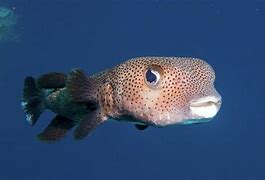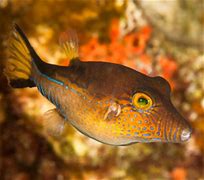Puffer Fish



Pufferfish, also known as blowfish or balloonfish, are intriguing and unique fish known for their ability to inflate their bodies into a round, spiky shape. Here are some interesting facts about pufferfish:
Inflation Defense Mechanism: Pufferfish have the remarkable ability to inflate their bodies by swallowing water or air when they feel threatened or stressed. This inflation helps them appear larger and more intimidating to potential predators. The expansion is due to the stretching of their elastic stomachs.
Spiky Appearance: When inflated, the skin of a pufferfish becomes covered in sharp, rigid spines, providing them with an additional layer of protection against predators. This defense mechanism makes them difficult to swallow and discourages potential threats.
Toxicity: Pufferfish possess a unique defense mechanism in the form of toxins. Many species of pufferfish contain a potent neurotoxin called tetrodotoxin in their internal organs, especially the liver and ovaries. This toxin is extremely dangerous and can be lethal to predators and even humans if ingested.
Habitat and Distribution: Pufferfish are found in various marine environments, including tropical and subtropical waters around the world. They inhabit coral reefs, estuaries, mangrove forests, and seagrass beds, among other coastal habitats.
Adaptations for Feeding: Pufferfish have a specialized mouth structure that enables them to feed on a diet consisting mainly of invertebrates, such as crustaceans and mollusks. They have powerful beaks and teeth that allow them to crack open shells and extract prey.
Camouflage and Coloration: Pufferfish often display intricate patterns and colors on their skin, which help them blend in with their surroundings. Some species have the ability to change their color and markings to better match their environment, providing effective camouflage.
Courtship and Reproduction: Male pufferfish attract females by creating intricate patterns on the seafloor using their fins. Once a female selects a suitable mate, they engage in a courtship dance. After successful reproduction, the female lays eggs that are guarded and cared for by the male until they hatch.
Culinary Delicacy and Toxicity: Despite their toxic nature, some species of pufferfish are considered a delicacy in certain cuisines, such as Japanese cuisine (known as fugu). Skilled and licensed chefs carefully prepare these fish, removing the toxic parts while retaining the unique flavor.
Conservation Concerns: Pufferfish populations face threats from overfishing, habitat destruction, and climate change impacts on their delicate marine habitats. The removal of pufferfish from ecosystems can disrupt the natural balance and ecological functions they provide.
Cuteness Factor: Pufferfish are often considered adorable due to their large, expressive eyes and rounded shape. They have become popular and beloved aquatic characters in cartoons, animations, and artwork.
Pufferfish are captivating and intriguing creatures with their unique adaptations and behaviors. While they are known for their defense mechanisms and toxic nature, they also contribute to the ecological diversity of marine environments.